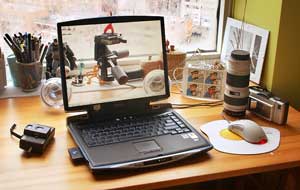
Every time your laptop sneezes or has underlying issues, the screen often shows signs of distress and unusual symptoms. Try to “take the pulse” of the screen and check your laptop to see what it might be “disturbed” by, and then adjust your settings and maintenance accordingly.
RAM Issues
Instead of the friendly interface you usually encounter, you might see a blue screen with error code L232 and a message full of numbers. There’s no need to panic. Write down the entire code, such as 0x0000… (….,…..,…..), to easily look it up online to find out what the error is. Usually, this error pertains to hardware, and a simple re-setup may resolve everything.
In another case, the screen may also turn blue, but the message indicates a RAM Dump after the machine has been running for a while. Accompanying this phenomenon is the machine restarting and turning back on automatically.
The error message clearly indicates that the issue is related to the RAM. To accurately assess the severity of the RAM issue, you can try reinstalling Windows. If that doesn’t work, there’s a 99% chance the problem is with the RAM. Alternatively, you can borrow a compatible RAM stick to check for stability. If you want to avoid prematurely discarding the RAM, you can also take a risk and clean it.
RAM issues often arise due to dust accumulation on the pins or loose contact points, which can prevent proper connection with the motherboard. If your machine has one RAM stick, follow these steps: Open the RAM compartment -> Remove the RAM -> Gently clean the pins -> Reinsert and check again. If your machine has two RAM sticks, do the same for the second one but remember to reinstall the first RAM stick afterward.
Moreover, if your machine has strong specifications, installing Memtest software is essential for regularly “checking the health” of the RAM. Of course, if after all these efforts the RAM remains inactive, you will need to replace it.
Installation Errors
About 30 minutes after the machine starts running, if you’re watching an exciting movie and the images appear smudged with distorted colors, a restart may resolve this temporarily. However, the machine might still occasionally show signs of distress. This can be caused by various factors.
Distorted images often occur with machines after a reinstallation, particularly when the Windows version isn’t appropriate. For example, if your machine runs Windows XP Home, but you mistakenly installed XP Pro SP2. If you use the original version to update drivers during installation, there won’t be any issues. However, using a lower version than the original to update will immediately cause screen reactions, even though other functions continue to operate normally. To resolve this problem, press ALT+F4 to close all programs and then reset the machine.
Incompatible Resolution
One of the common issues in laptops is that text in Windows appears smeared or jagged. Each laptop LCD requires a specific resolution to display the size and colors of data correctly. Incorrect resolution adjustments can distort displayed information, so first, check the screen resolution.
If you’re not technically savvy, visit a reputable service center to have the settings accurately reconfigured. If adjustments do not resolve the issue, you should also check the font and seek solutions. This issue can often be resolved by reinstalling the font. The graphics card driver is another aspect to consider, as an incompatible driver can also lead to such text issues. Ensure to select the correct driver from the manufacturer for updates.
Cable or Card Damage
Another cause of distorted application data on the screen can be due to loose or damaged cables connecting to the motherboard, or an issue with the graphics card chipset. Common symptoms include distorted colors, smeared text, and images turning red or, worse, losing color entirely. Try connecting to an external monitor; if the symptoms persist, the issue may be with the graphics card chipset (which, when damaged, often cannot display colors or images).
The simple diagnoses and solutions provided above aim to help you understand the deeper causes of common laptop issues. From there, you can handle problems promptly, maintain your device properly, and avoid unnecessary repair costs. Additionally, there are numerous other causes stemming from users forgetting to adjust the default configuration settings.
For example, issues may arise from the power settings where a choice between using power supply or battery, and sleep or standby modes are improperly configured. Sometimes, selecting one option while the machine performs another can lead to confusion, such as choosing to use power supply but disabling the backlight, which causes the system to shut off the screen when simultaneously charging and activating the machine.
If after following all the steps above the problem persists, you should take your machine to a professional repair center. Here, you will receive advice and configuration of software programs and drivers suitable for your machine’s specifications and your specific work needs. Some errors occur due to inadequate driver installation (when all standard drivers are installed, the machine operates more stably).
Quick Tip: Recently, many customers have inquired about why their machine runs slowly on battery power but much faster on AC power. The principle is that whenever a laptop runs on battery, it automatically reduces speed to conserve power, which can make it feel slower. If this is inconvenient, you can disable this feature in the BIOS or the Power Management program in Windows.
Furthermore, continuous use of AC power for extended periods with little battery usage can result in longer startup times when switching to battery, as the machine takes time to recalibrate.
Vi ái Dân




















































